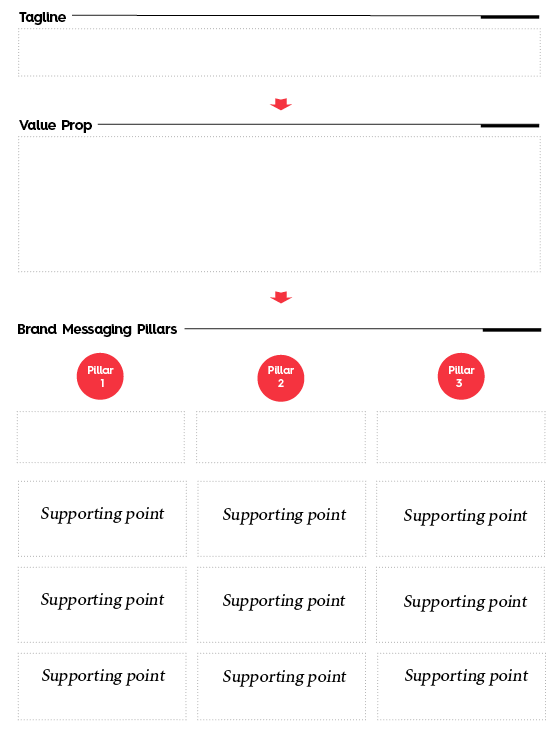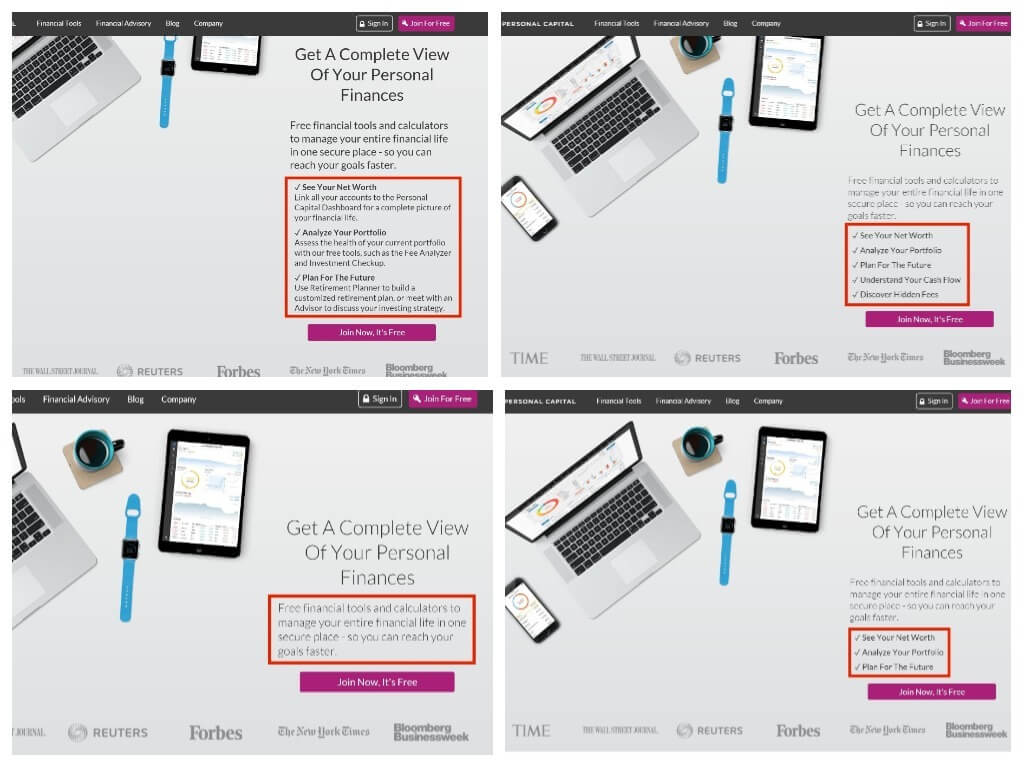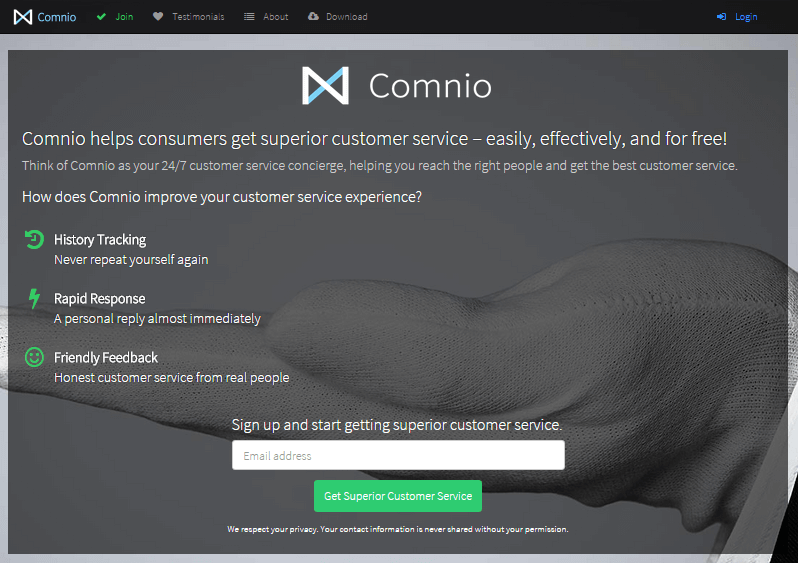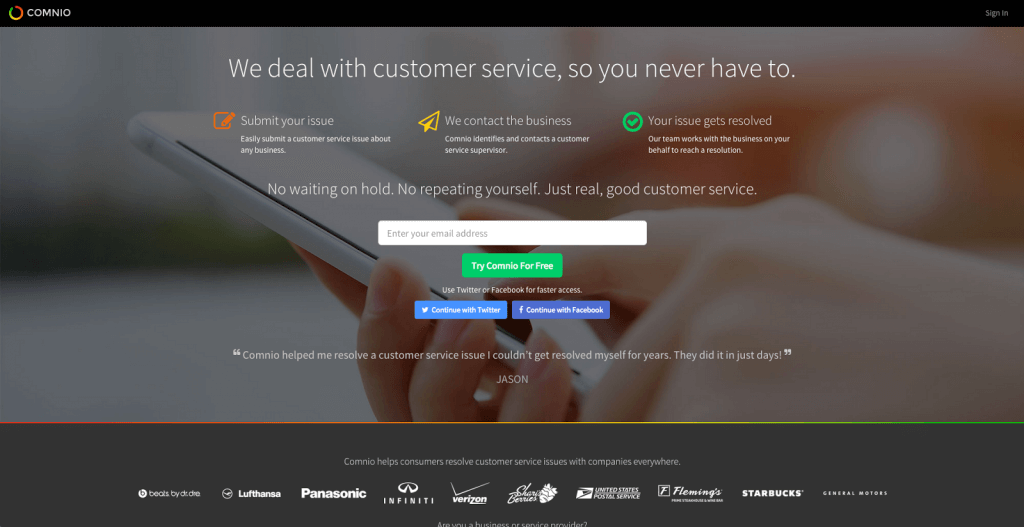Your value proposition is one of the most important elements of your brand messaging. It’s a powerful tool to pique someone’s interest, communicate who you are, and entice them to work with you—or, at the very least, learn more about you. It’s also a vital piece of your brand messaging framework.
A quick overview:
- Your tagline is your big idea.
- Your value prop is what supports your big idea.
- Your brand messaging pillars are the stories you tell to support your value prop and tagline.
Together, these create a brand messaging hierarchy that looks like this:

Tip: You can download our Brand Messaging Template below to document your final value prop once you complete this exercise.

Each element is crucial to help you communicate effectively, craft compelling copy, and convert people. But they can also be tricky to craft—especially your value proposition.
This is why it’s important to tackle each element separately. And, although the framework is a top-down hierarchy, we actually recommend starting with your value prop, as it is the core of what you do.
That said, we also know how intimidating this work can be, which is why we’re making it easier for you. Here, you’ll find a simple step-by-step guide, including the tools and tips you need, to write your value proposition. (We also included some fascinating research and inspiring examples to show you how it’s done.) No matter how lost you are, this should help you get through the process as painlessly as possible.
What Is a Value Proposition?
A value prop is a succinct explanation of both the functional and emotional benefits your product or service provides to customers. It’s not just who you are and what you do differently (aka your positioning); it’s also how you solve their problem and why they should choose you over the competition.
Putting your value proposition front and center is crucial for successful marketing. It’s what you should lead with on your site, and it’s what all other messaging should support and reinforce.
What Makes a Good Value Proposition?
A strong value prop needs a strong hook. It needs to communicate your brand’s what and why in a way that:
- Speaks to your audience
- Is clear and concise
- Communicates a brand promise
- Is descriptive
How to Create a Value Proposition
If you’re scheduling a single brainstorm with the expectation that you’ll emerge with a perfectly crafted value prop, you’re likely to leave frustrated and burnt out. (We know this firsthand.) It’s a lot easier and more productive to follow this process step by step. You may need to have multiple brainstorms (with relevant stakeholders), so consider your team’s unique needs as you embark on this exercise.
Step 1: Clarify Your Brand Heart
More often than not, when a brand struggles to articulate their messaging, it’s because they don’t have a strong Brand Heart (purpose, vision, mission, and values). If you want to communicate effectively, you need to identify who you are and why you’re in business in the first place—and that is encapsulated in this core identity. If you haven’t done it already, document your:
- Purpose: Why do you exist?
- Vision: What future do you want to help create? What does the future look like?
- Mission: What are you here to do? How do you create that future?
- Values: What principles guide your behavior?
This simple exercise will help you approach your value prop with more clarity and a stronger sense of identity.
Tip: Download our free workbook to articulate your Brand Heart quickly and easily.
Step 2: Complete a Competitive Analysis
If you want to stand out, your value prop needs to pull people to you—and away from your competition. To do this effectively, you need to communicate how and why you’re different, which is why a competitive analysis is vital. It helps you truly “see” where you stand compared to the competition, specifically how you’re positioned in the market. It also gives you valuable insight into how other brands are marketing themselves so that you can differentiate yourself.
Tip: If you haven’t done one already, follow our guide to do an analysis in 5 steps, which also includes a free template.
Step 3: Know Your Personas
Your value prop isn’t written for you. It’s written for the people you want to do business with. Therefore, it’s crucial that it speak to them and not at them (a very common problem with weak value propositions).
Personas identify demographic and psychographic info that gives you insight into who these people are, what they care about, and how to communicate with them. This helps you better tailor your value prop to speak to their core needs.
Tip: Use our simple guide to create personas. Once you start to work on your value prop, you can use these personas to vet how impactful it is.
Step 4: Brainstorm Your Benefits
Up to this point, you’ve been absorbing the information you need to help you effectively articulate your value proposition. Now you can actually dive in. To start, brainstorm all the benefits you can think of, including:
- Functional: For example, if your software automates marketing emails, your functional benefits might be something like “automation” and an “easy-to-use interface.”
- Emotional: Your emotional benefits might be that it “saves time,” “eliminates confusion,” or “helps you build a stronger relationship with customers.”
You can condense, combine, and refine these benefits later. What you want here is a master list to trim down.
Step 5: Iterate a Rough Version
This is the fun and challenging part. Identify the most appealing, relevant, and unique points of differentiation from your list. Those will be the elements to lead with.
Try to articulate the most simple version of your prop first, then you can refine or expand. We find Steve Blank’s XYZ template to be helpful here:

It’s a simple exercise, but it helps distill your thinking. A few additional tips:
- Think of your target customer and the problem you’re solving. If you were suffering and seeking a solution, what would you want to hear from your savior (aka your brand)?
- Don’t get too fancy. Your language doesn’t have to be frilly; it just has to be impactful. It’s better to err on the side of directness and simplicity than confuse your reader with fancy language.
- Translate it into your brand voice. There’s a fine line between simplicity and generic corporate speak. If your value prop headline could work for any of your competitors, iterate a bit more. You want your personality to shine through immediately. (Follow our guide to find your brand voice if you’re not sure what yours is.)
Once you know what you’re trying to say, you can experiment with the most impactful format.
Step 6: Perfect the Presentation
There isn’t a single rule for how you format your value prop. It may be two sentences. It may be a headline, blurb, and a few bullets. It’s important that you communicate succinctly, but you always want it to be impactful.
On that note, your website homepage is where your value prop will live, so it’s important to consider how your viewer will encounter it. Recent research provides a few interesting insights about how you might tailor your presentation online.
In 2017 the CXL Institute ran an interesting study to test how different value prop presentations affect a viewer’s experience. Using eye-tracking and survey tools, they tested four different formats, tweaking image placement and the amount of text that appeared.

Image courtesy CXL Institute
The results revealed a few surprising things:
- More text got more attention. When text took up more space, users noticed it more quickly.
- More text took more time. When text took up more space, users spent longer reading it.
- More info means more recall. The more details included, the better users could remember the purpose of the service. Similarly, when more services were listed, they could recall more services.
- Bulleted lists were better. Users preferred text design with a few bulleted items.
Now, although the amount of information played a role, that doesn’t mean that you need to write a novel-length value prop. The placement and design of the text made it a more prominent element on the page, which is an aesthetic choice. The real takeaway here is that the more info you can communicate and the clearer your message, the more it can hook a reader’s interest.
It’s also increasingly clear that design plays a significant role in how a value prop appears. Research shows that headlines, subheads, copy, and bullet points can help readers absorb a value prop more effectively—and lead to increased conversions.
For example, when the team at Conversion Sciences remade Comnio’s value prop, they increased signups an astounding 408%. How did they do it? By strengthening the value prop and simplifying design.
It starts with the headline. As you can see, their original headline wasn’t exactly thrilling. “Comnio helps consumers get superior customer service—easily, effectively, and for free!”

Sure, it describes what they do. But it doesn’t communicate the why, which is the emotional hook, and it doesn’t feel very personal. To make it more impactful, Comnio identified the major emotional benefit and used the second person “you” to speak directly to the reader.
“We deal with customer service, so you never have to.”

That simple, punchy phrase draws readers in to find out how Comnio does that. Three simple supporting subheads highlight the functional benefits, along with a clean image and intuitive hierarchy, giving the reader all the info they need.
These simple, subtle changes make for a value prop that makes a big impact on the viewer—and the brand’s bottom line.
Remember: A strong value proposition takes time.
Finding the right value prop is a process that takes patience and collaboration, so don’t get discouraged if you’re struggling a bit. (You can also try these tips for a better brainstorm.) We also suggest A/B testing to see what resonates most with people.
Don’t Forget Your Other Brand Messaging
A strong value prop is crucial to communicate your brand effectively. But it’s not just that single paragraph that matters. The way you sound, the way you speak, the way you look—all of these things influence how your brand is perceived. For more ways to improve your impact:
- Follow our guide to craft a tagline. You can also check out these inspiring tagline examples if you need some inspiration.
- Identify your brand messaging. Follow our guide to build out your brand messaging, and try these tips to craft compelling copy that converts.
- Bring your messaging to life through content. Learn how to tell a strong brand story.
- Craft a cohesive brand strategy. If you’re building a brand from scratch, follow our step-by-step guide to build a brand strategy, and download our free brand toolkit below.

And if you need any help with your value prop or any branding challenges, consider bringing in extra support. Follow our tips to find a great creative agency, or holler at us. We’d love to help bring your brand to life.





Thanks so much for sharing. Your blogs save me a lot. I can learn many things in branding and marking from you. Keep doing it. I love the way you do.
This is great to hear!
Thank you so much! I love all of your articles. This was a great tutorial about how to dig deep into your company and expressing the values succinctly. You’re doing great work!
Thank you, Tika! Happy to help.
Hi C5, Thank you for the toolkit, but I didn’t understand the brand messaging if you could help me with the value proposition, the tag font, and the brand messaging pillars
If I have more than one product and service, do it for each product/service (value proposition, tag line, brand messaging pillars), or these are about the brand in general
Hi Oussama, your value prop/tagline is usually for your brand as a whole. For example, if you’re an athletic brand that is focused on delivering high-performance products that are sustainably made, those are the key points to outline in your value prop. But you would break down your brand messaging pillars even more for each product (e.g., you may want to tell stories about your shoes being durable, comfortable, and stylish, whereas your windbreakers might be sweatproof, light, and comfortable). Hope that makes sense.